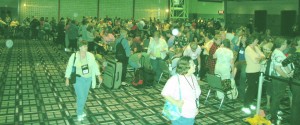Houston Quilt Market
Tuesday, October 28th, 2008I left Baltimore on Thursday, Oct. 23 and the trip got off to a good start. Do you know that the ladies rooms at the airport have vases filled with fresh flowers! I did touch them to make sure they were real, and it definitely gave my day a boost. Should have taken a picture.
Got set up some Thursday and continued on Friday morning. Here are some before shots of the hall. First up is the Superior Thread booth. Guess the crates are filled with thread! The second shot is the Michael Miller Fabrics booth, which in its finished state won one of the booth prizes.
Friday was filled with Schoolhouse, classes geared to shop owners to help them market products in their shops, and a variety of educational lectures. Friday night is Sample Spree, a hugely popular event. Here’s a shot of the masses of people waiting to get in. The spree opens at 8 pm and attendees get in in two waves. The first person was in line at 2:30 pm!
The show opened to the trade on Saturday morning at 8:30. It’s such a transformation from vast open spaces to small shops and displays. I saw several new notions. Anyone need a whacker? It’s a hammer to use to whack those pesky seams flat. And, everyone seems to be eating at the same bakery: lots of jelly roll, turnover and layer cake fabrics, books, patterns. Still fun decorator prints in bright colors, though I did notice some browns creeping back in. Overall, you can find colors that appeal to anyone’s desire. Plenty of people stopped by the booth during the show. Here are some shots.
Here’s Jake FInch, who is has a new book on Community Quilts with C&T and was just named Managing Editor for Mark Lipinski’s Quilter’s Home.
And speaking of Mark, he popped in, too.
Did some walking on the floor and ran into Jay McCarroll, Project Runway’s 2005 season winner. Jay has now designed two fabric lines for FreeSpirit Fabrics. You can see bits in the background of the photo.
I’m lucky to have area quilters loan me quilts to hang on display in the booth. One of those quilters is Kim Ritter. Here we are in front of her quilt “Trowel and Error.”
The last two issues of the The Professional Quilter included articles on blogs by Maria Peagler. Maria stopped into Market to make contacts and sales of her book Color Mastery that comes out in early 2009.
Ricky Tims also stopped by.
And, my booth was catty-corner across from Linda Taylor and she stopped in for a visit.
Since I’m the editor of The Professional Quilter, I know lots of the editors at other magazines. Jan Magee, editor-in-chief of Quilters Newsletter and I compared notes on the show.
We have a break between Market and Festival, starting back on Wednesday evening at 5 pm. I’m looking forward to seeing the quilts, something I save for Festival. More in a couple of days.



















